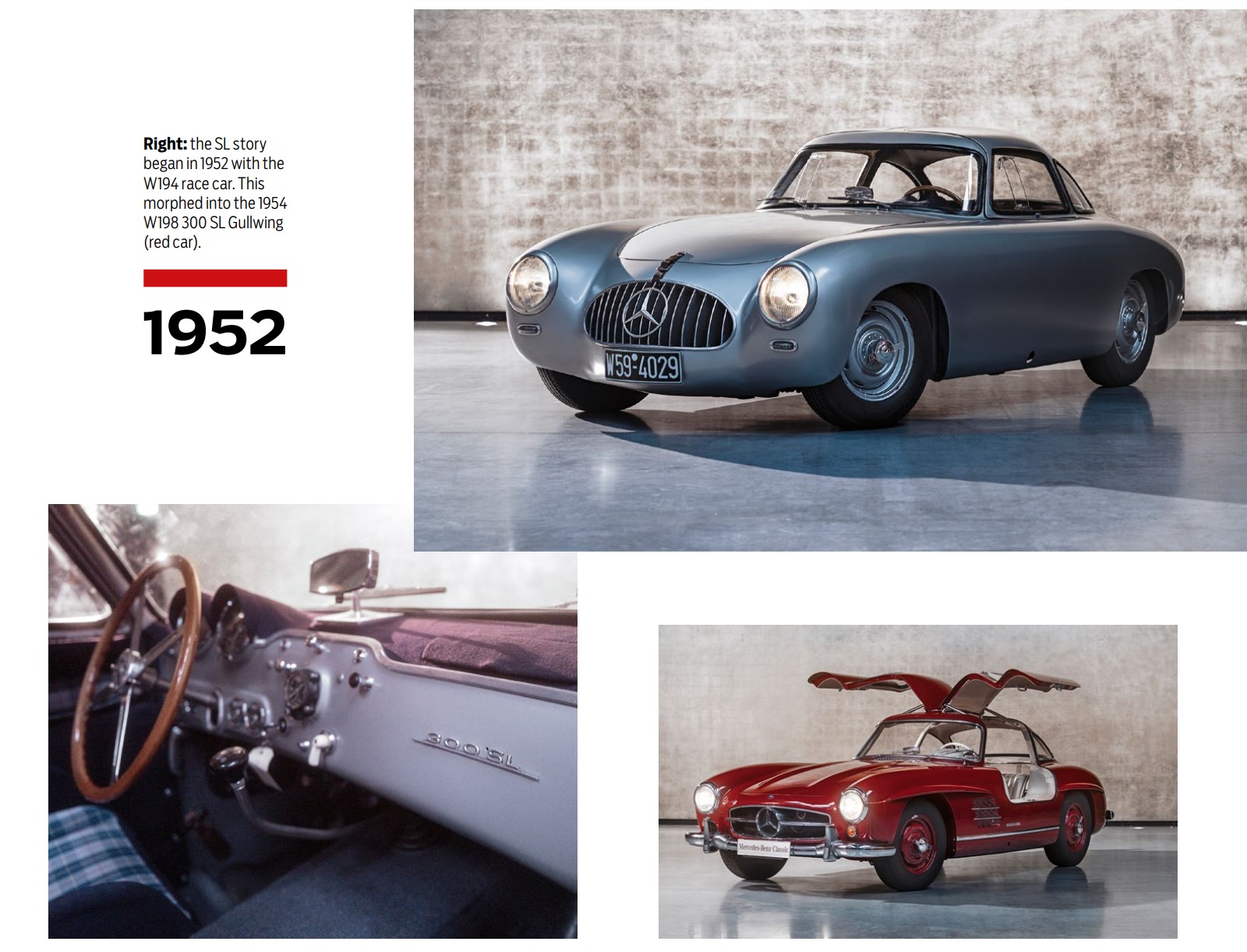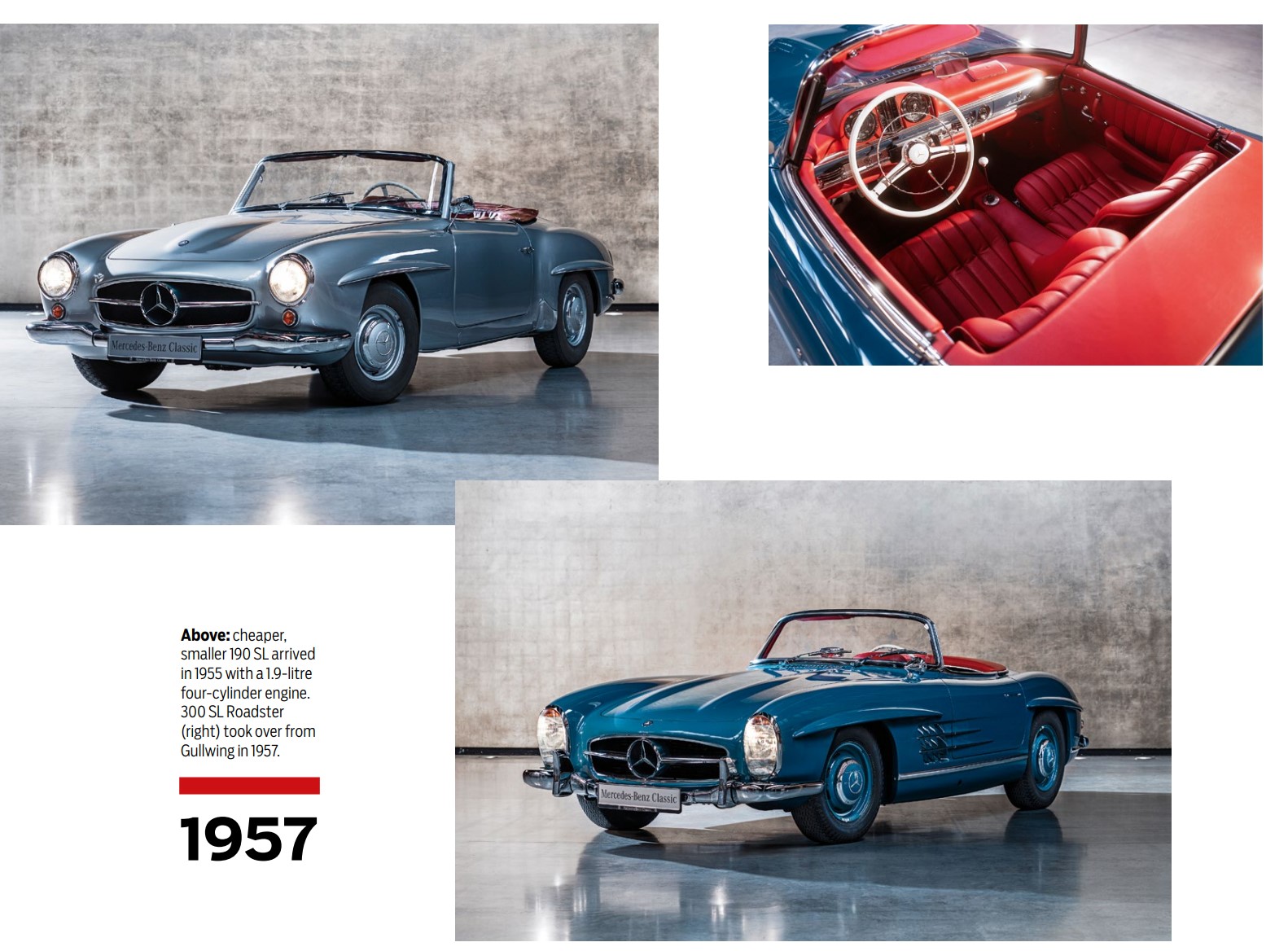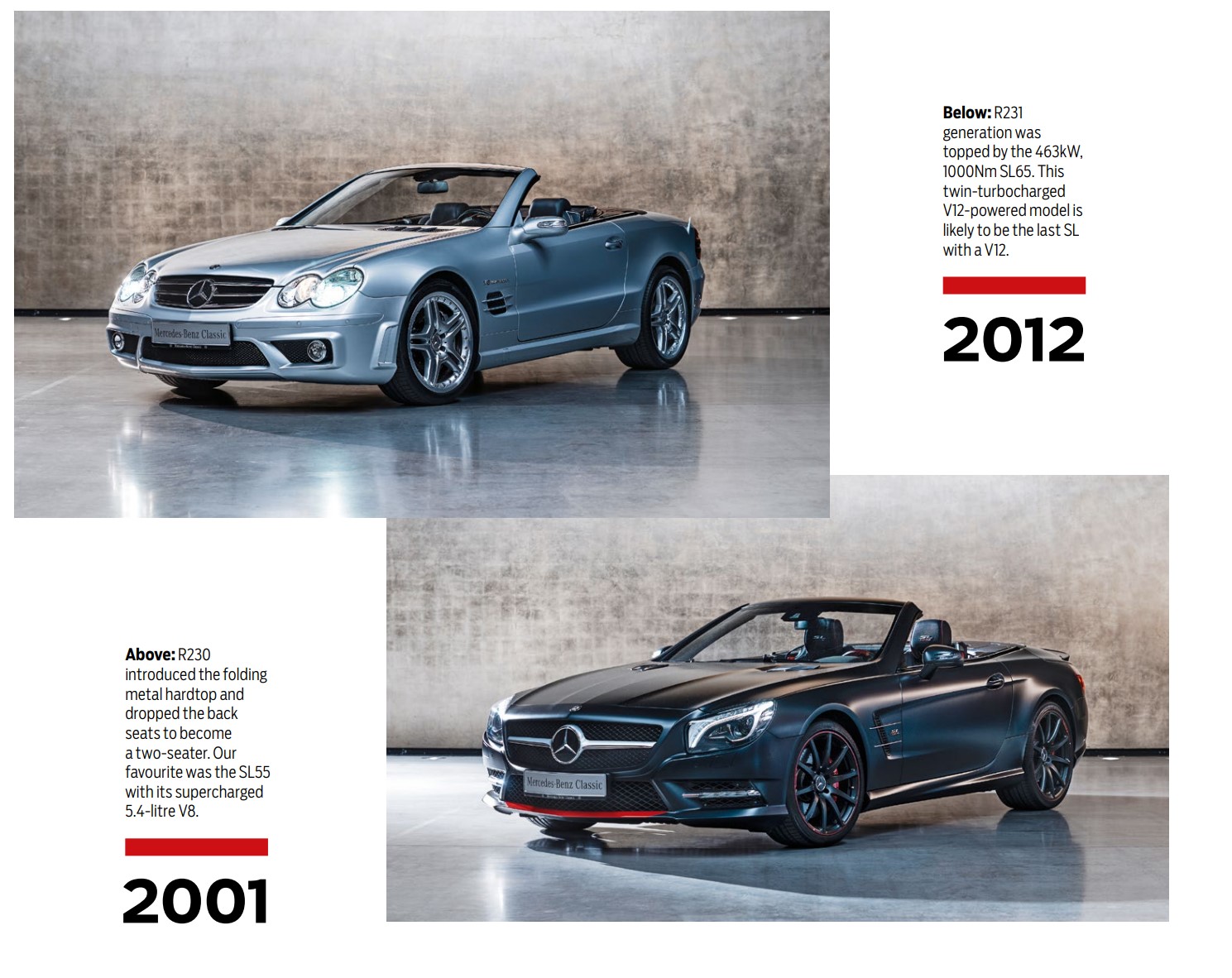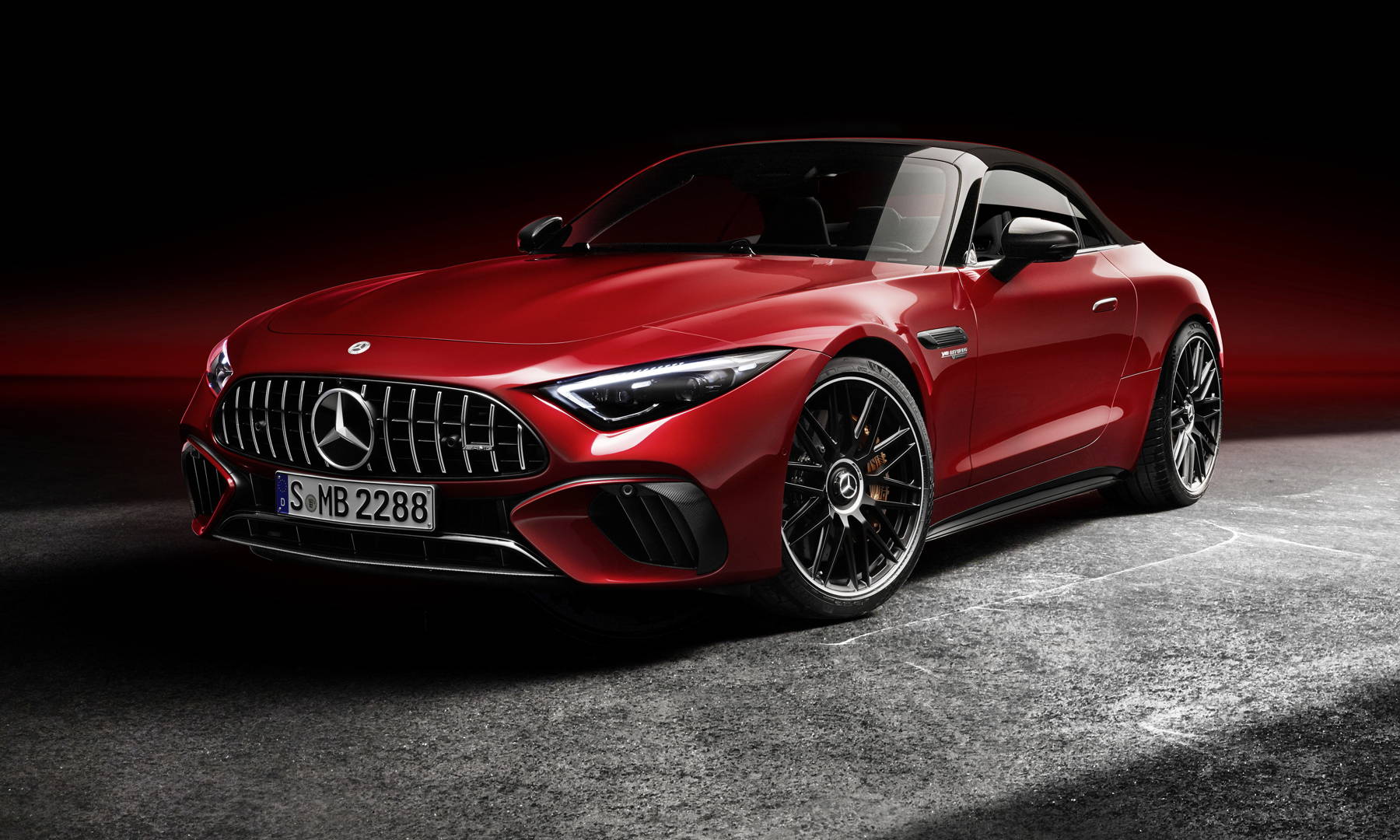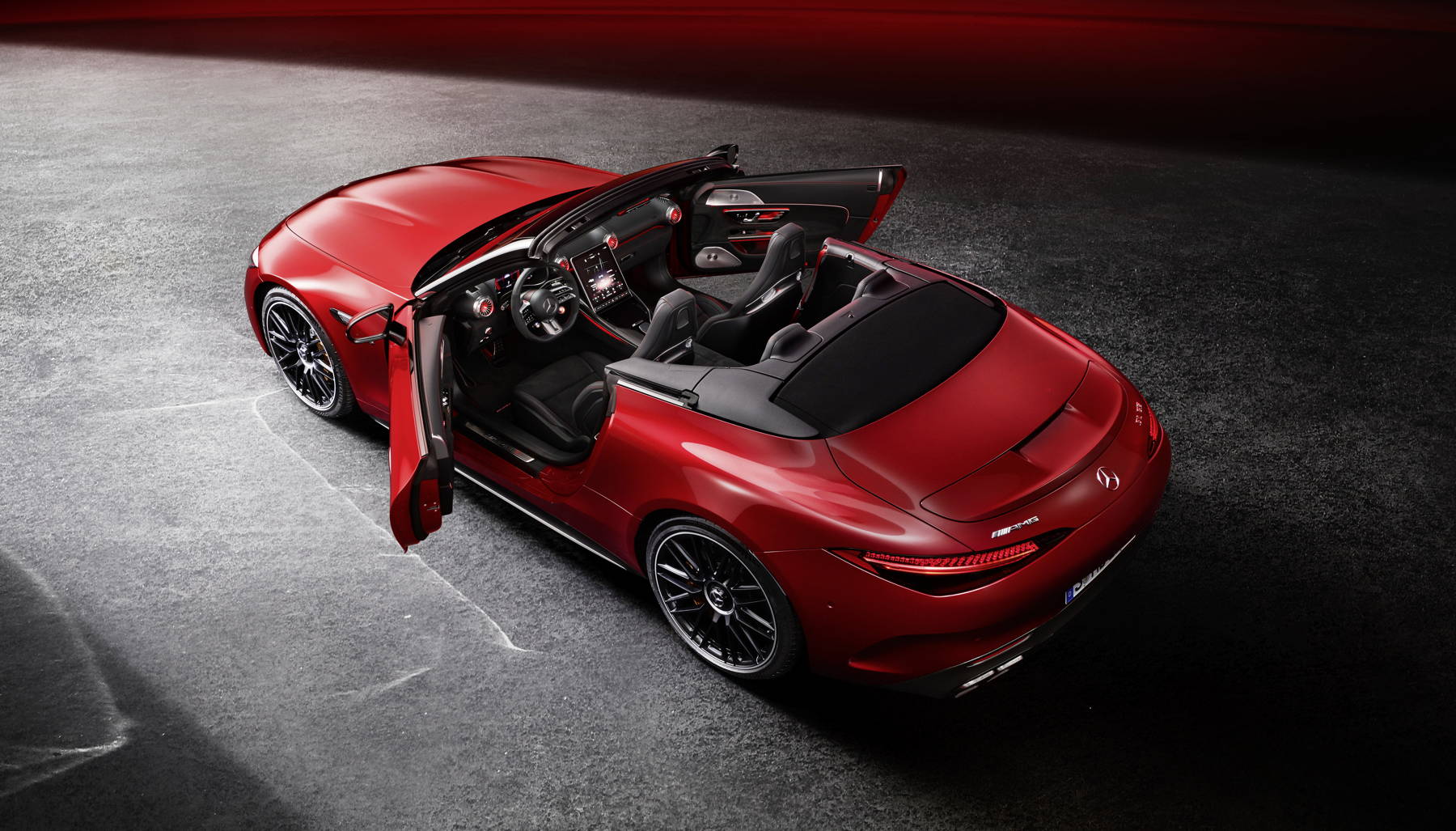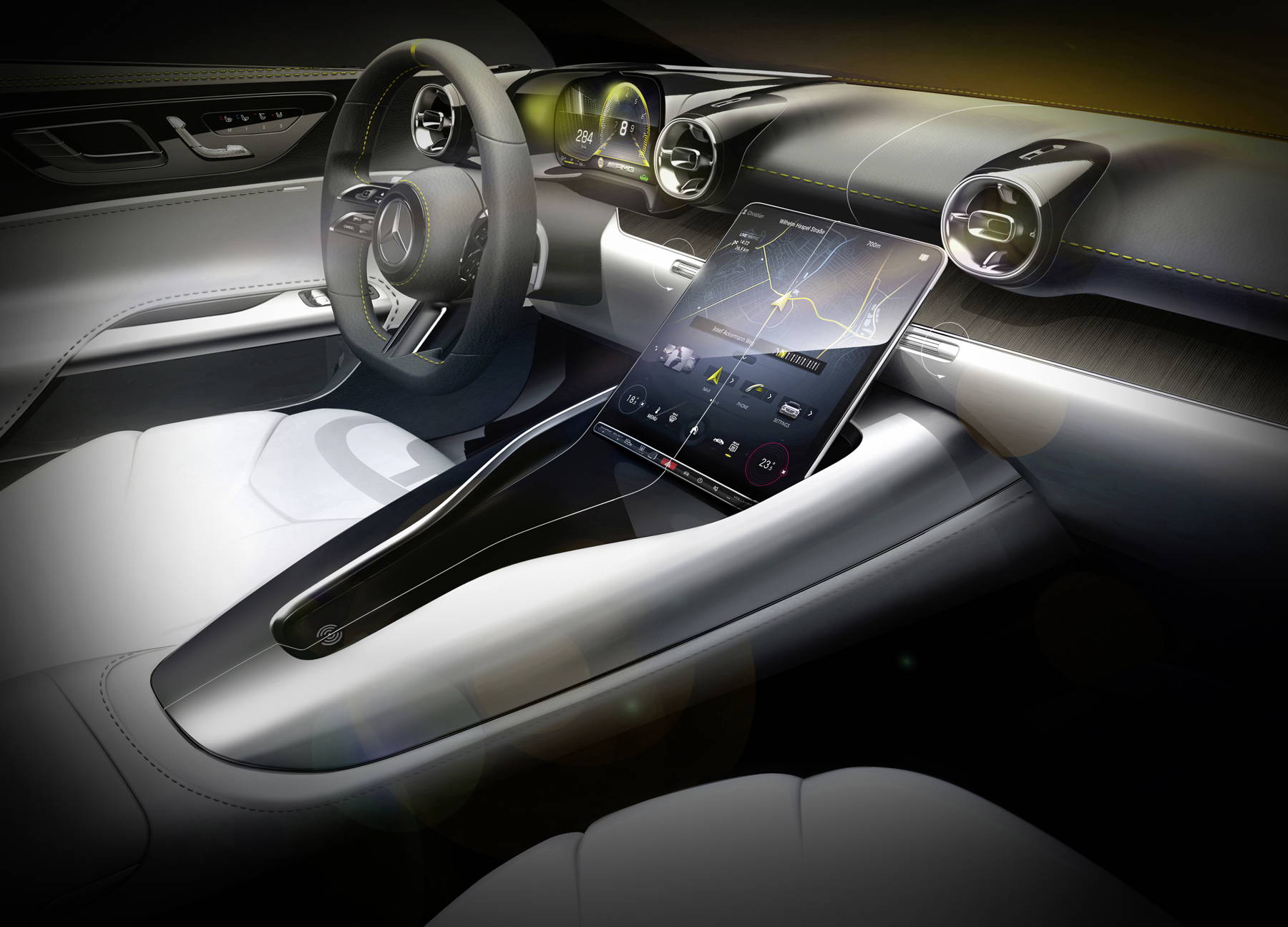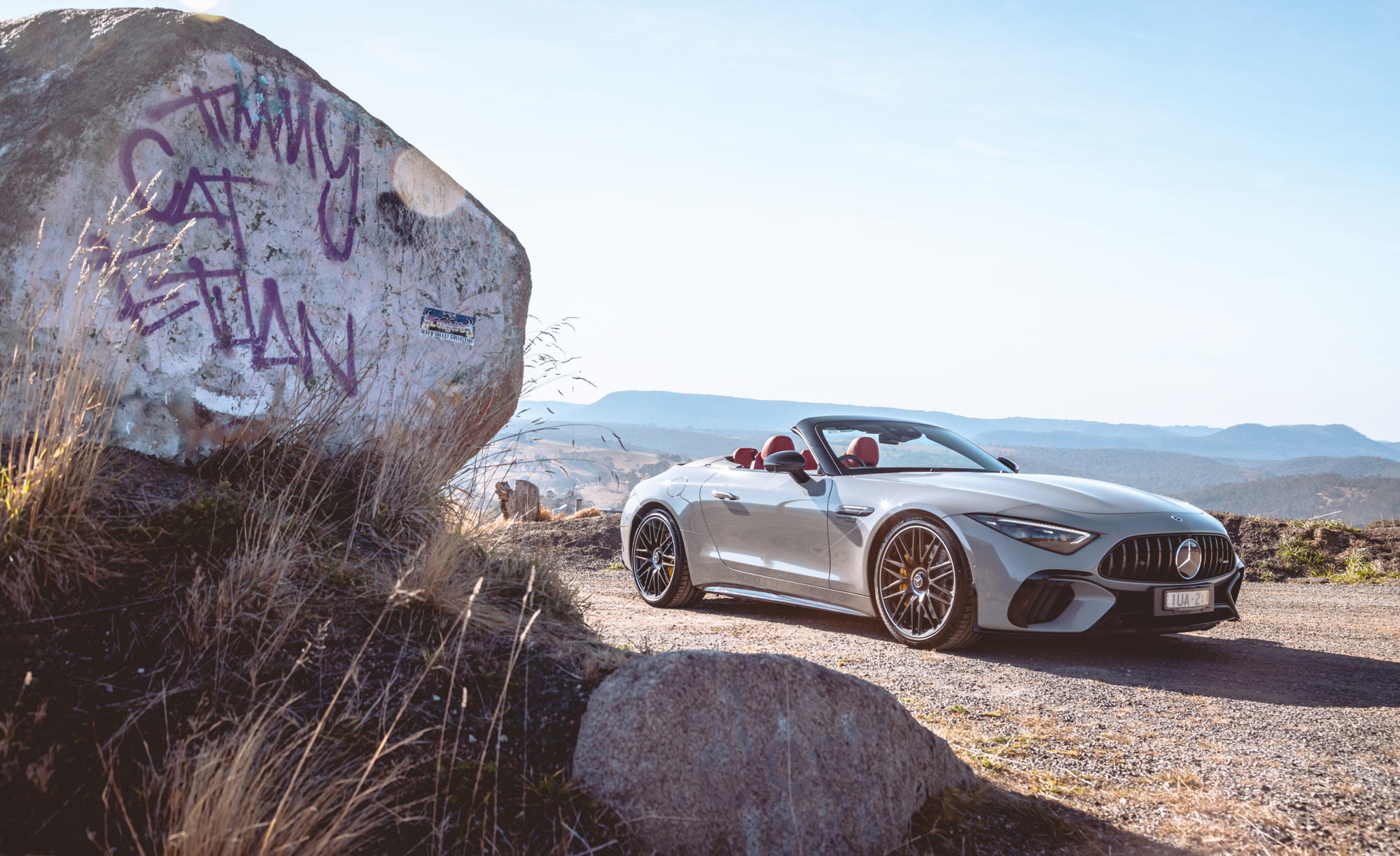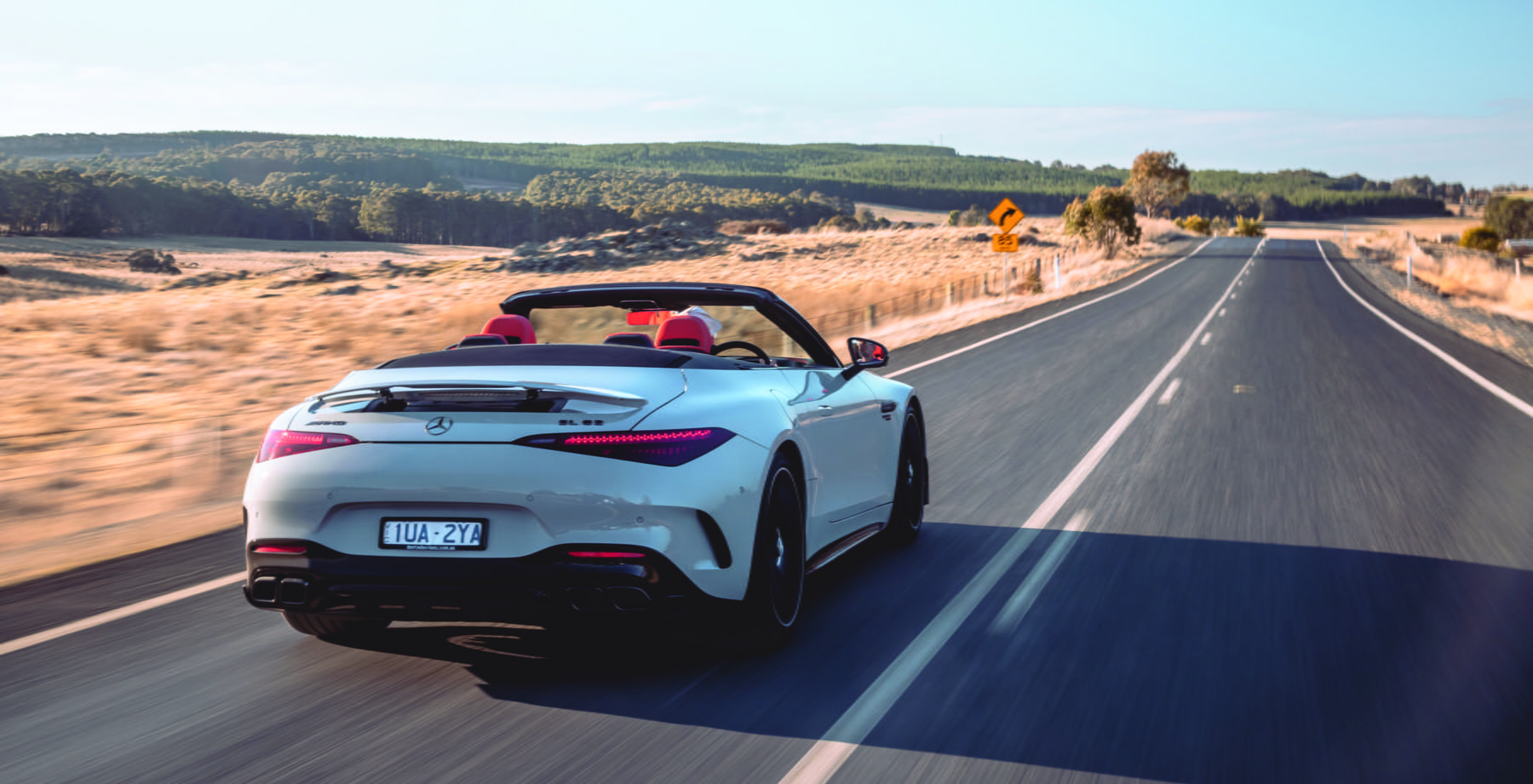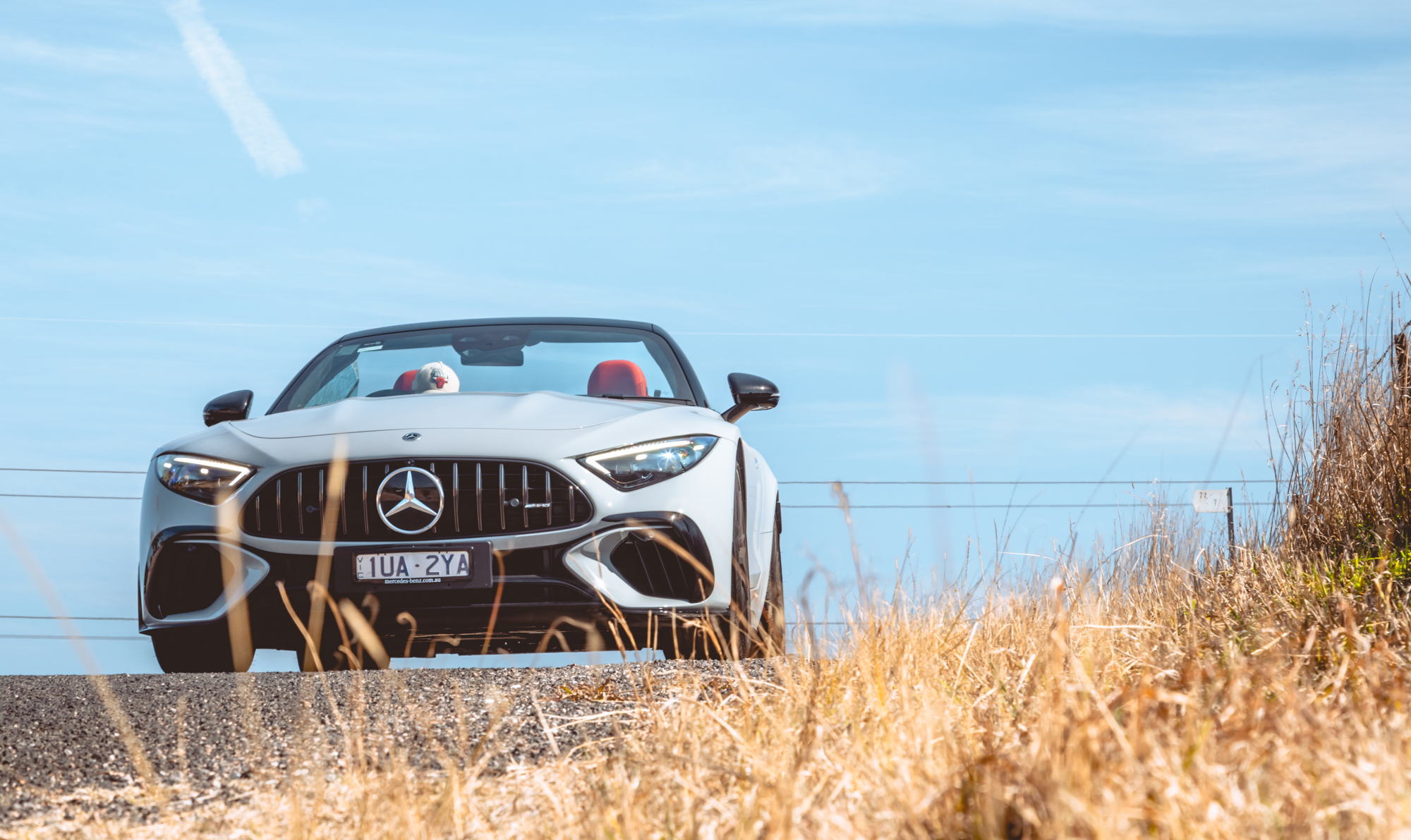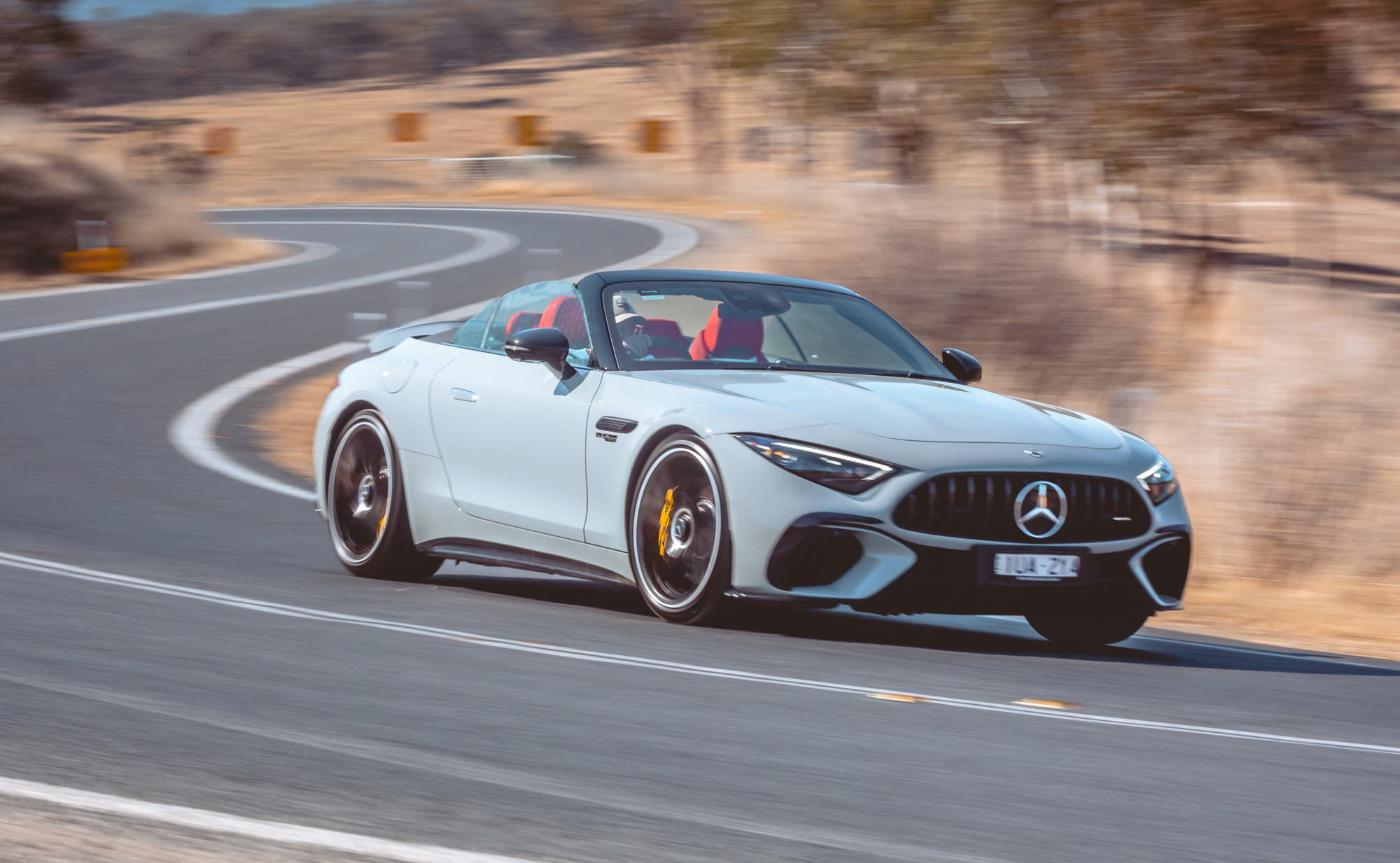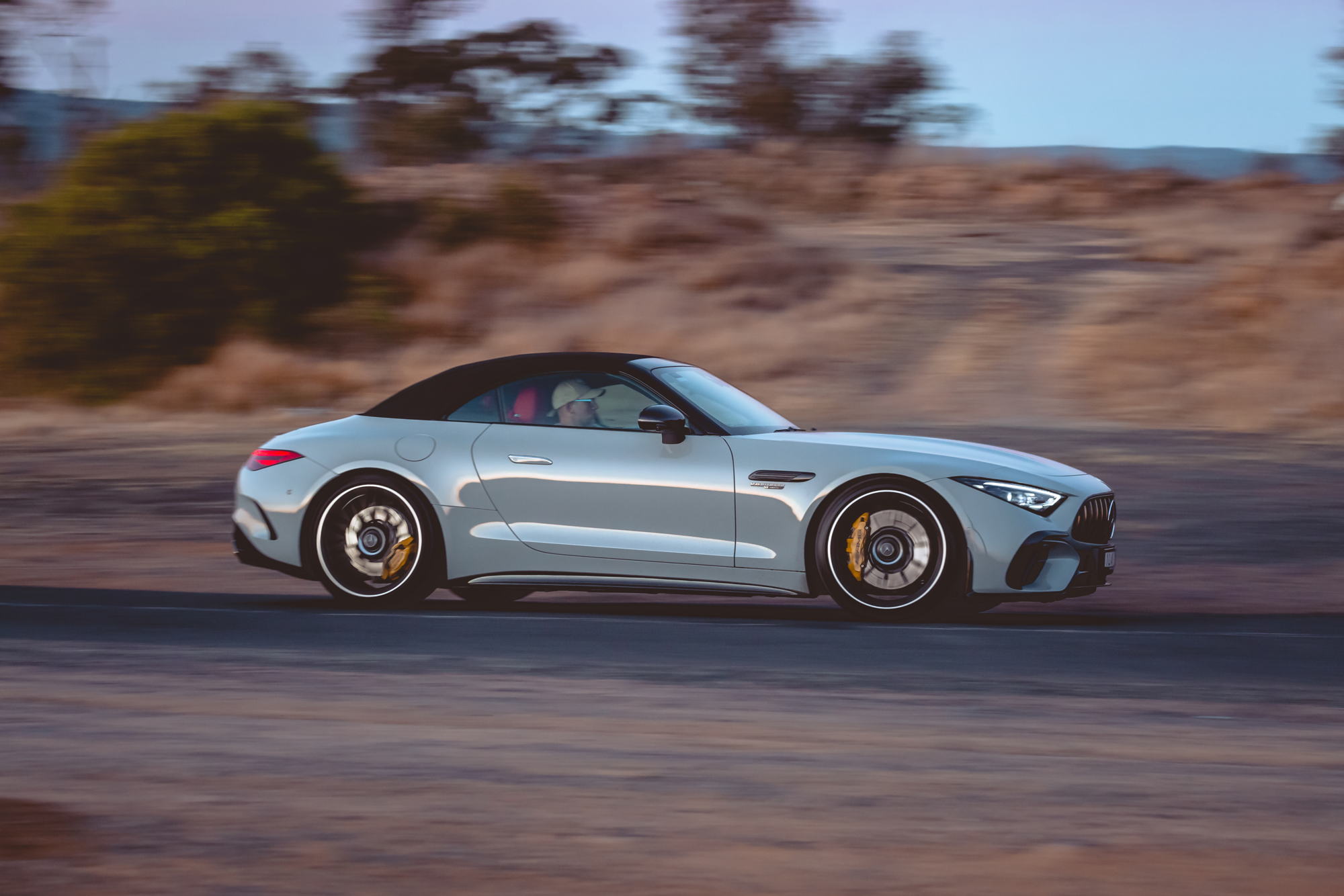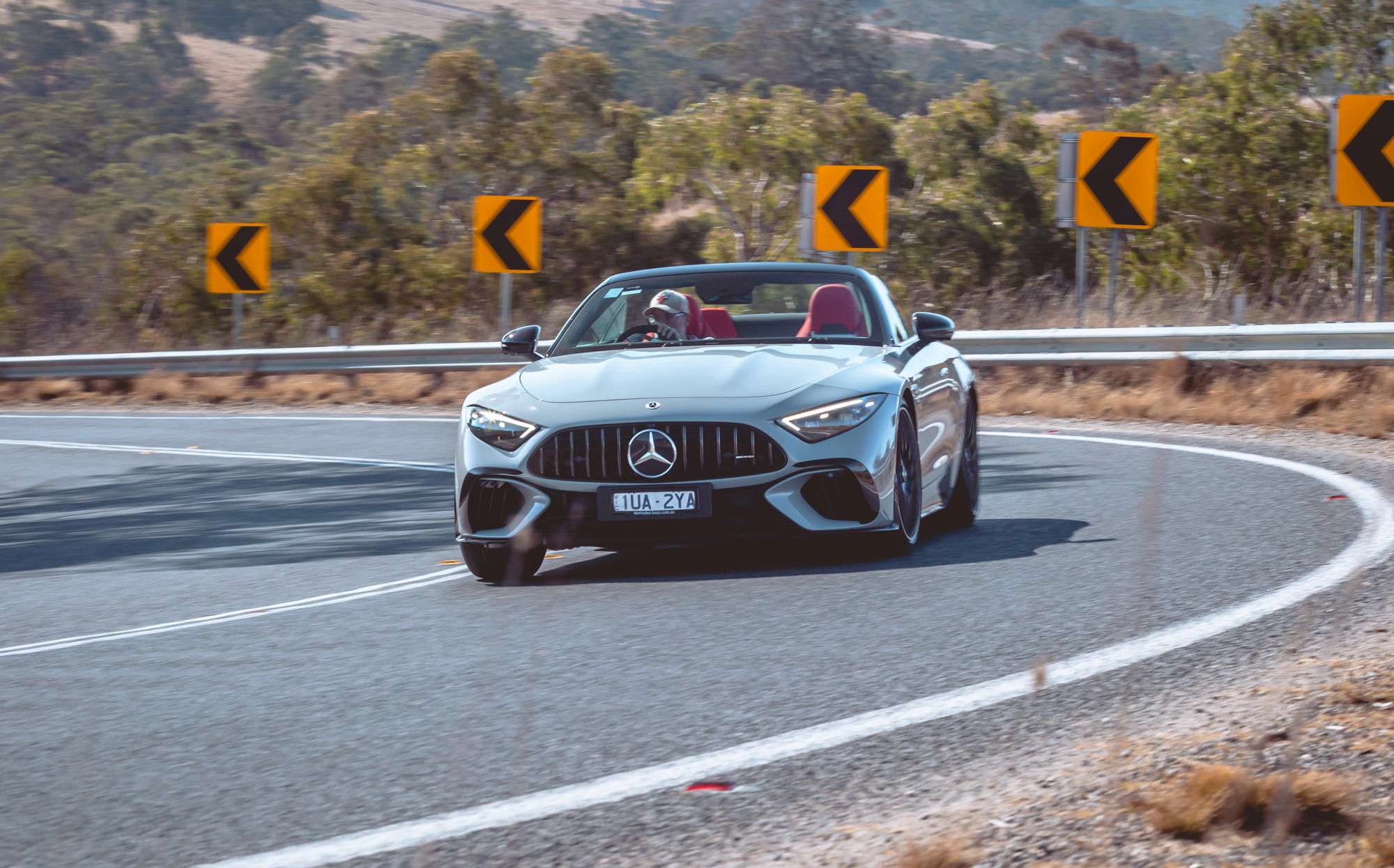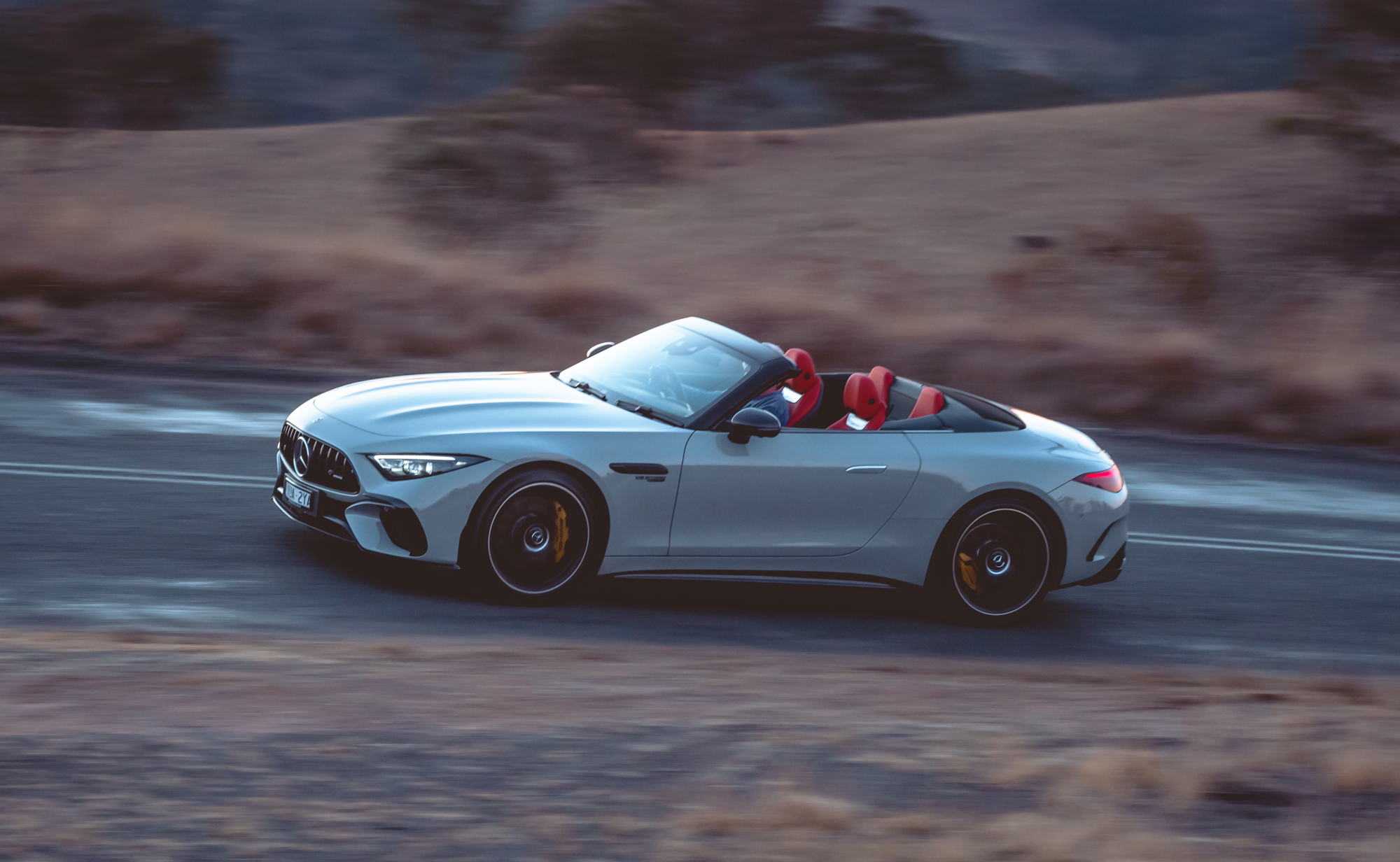Mercedes SL 63 Special Feature
A Star is Born
Across seven generations, the Mercedes SL has established itself as a true automotive icon. With the arrival of the new R232 generation, we trace the model’s history from birth to present day.
FEW AUTOMOTIVE NAMEPLATES carry the weight and historical significance of the Mercedes SL badge. Depending on your definition of a car, the SL is the longest-lived continuously used badge in the industry. In terms of badges with a longer unbroken lineage, only the Chevrolet Suburban can dispute the SL’s longevity. But with its truck-based roots, is the Suburban really a car?
Regardless of your level of pedantry, the SL badge sits in the pantheon of greats beside 911, DB and GTO. So, a brand-new generation is a big deal.
Indeed, the new R232 SL is only the seventh generation since the model debuted as a racing car in 1952 and road car in 1954. Initially, Mercedes-Benz had no intention of developing or offering a road-going variant of its W194 300 SL race car, as the company was busy rebuilding its racing efforts in the decade after World War II. However, US importer Max Hoffman recognised a gap in the post-war market for sporting and luxurious ‘personal’ cars. Such was the pull of Hoffman and his cars-to-the-stars business in the United States that Mercedes set about substantially modifying and taming the W194 racer for road use. Hoffman put his money on the line and ordered 1000 cars to guarantee the production run.
In what has become a sometimes trademark for the brand, the road-going W198 300 SL retained the racer’s gullwing doors and a legend was born. Beyond the doors, the 300 SL Gullwing featured a turbine-smooth 3.0-litre straight six and four-speed manual gearbox. The engine made 158kW, an unheard of output at the time, and the slippery Gullwing reached speeds of 250km/h – little wonder that the 300 SL is often argued to be the world’s first supercar.
It turned out to be a smart bet for Hoffman as the 300 SL caused an immediate stir and wealthy Americans were scrambling to get on the waiting list. Such was its success, that when the smaller, more affordable 190 SL arrived in 1955, Hoffman ordered 1000 units of the new model. Powered by a 1.9-litre four-cylinder engine, the 190 SL was built on a shortened version of the W121 sedan’s chassis, rather than the very expensive W198 tube-frame chassis that had been adapted from the W194 race car.
When production of the 300 SL Gullwing finished in 1957, it was replaced by the Roadster variant that become even more popular. After the 1400 Gullwings were made, 1858 300 SL Roadsters were snapped up.
Both the 300 SL Roadster and 190 SL ceased production in 1963 and were replaced by the hugely successful W113 generation. Designed by Paul Bracq (who would later go on to design the BMW Turbo concept and E24 6 Series) and Bela Barenyi (legendary engineer and passive safety inventor), the W113 would sell 48,912 units across its eight-year production run. The SL continued its popularity in the US with nearly 20,000 sales occurring Stateside.
The W113 was powered by a fuel-injected in-line six of 2.3, 2.5 or 2.8 litres. The model also famously introduced the concave Pagoda removeable hardtop.
The R107 arrived in 1971 and would remain in production until 1989. Despite the impact of the 1973 fuel crisis, the R107 boomed in popularity with 237,287 built over its extended production run.
The third-generation SL also spawned a coupe known as SLC (model code C107) that was even developed into a successful endurance rally contender and somewhat successful WRC campaigner in the late 1970s. These successes led to a plan for Walter Rohrl to drive for the team in 1981, fresh off his first world championship in 1980 driving for Fiat. Sadly, the C107 WRC programme was cut for the 1981 season. Still, 62,888 SLC coupes were built before production ended in 1981. It’s estimated that nearly 70 percent of all R107/C107 models were sold to the US.
The fourth-generation (R129) model of 1989 introduced a number of firsts for the SL nameplate, chief among them being the introduction of a fully-automatic hydraulically operated folding soft top. The R129 also featured a pop-up roll hoop that automatically activated in the event of an emergency. As a few journalists discovered, the extremes of road-testing (especially on a circuit) were enough to fire the hoop into action.
In addition to the usual offerings of in-line six and V8 models, the R129 was the first SL to introduce a V12 to the range and the first to officially offer AMG variants. The most extreme examples of both being the SL 73 AMG featuring a 7.3-litre V12 that later found a home in Pagani Zondas.
The R129 was also the final SL model to be offered with a manual gearbox.
It’s also worth noting that it was during the R129 model cycle that the naming convention changed from suffix to prefix – 500 SL to SL500.
In 2001, the R230 arrived with a folding metal hardtop, bringing coupe and convertible duality. Nearly 170,000 R230s were built, with around 100,000 being the SL500 model that was powered by a naturally aspirated 5.0-litre V8 and later an NA 5.5-litre V8. The R230 generation also introduced the first and only SL Black Series – the SL65 Black Series. This twin-turbocharged V12-powered monster made 493kW and 1000Nm. Just 350 examples were built, making it one of the rarest SL models ever produced.
The R231 followed in 2012, and debuted a largely aluminium structure and body that saved around 140kg over the R230 model. The range was topped by the twin-turbocharged 6.0-litre V12-powered SL65 which produced 463kW and 1000Nm. This is likely the very last V12-powered SL ever made.
The seventh-generation SL – the R232 – has now arrived. We dive under its skin and then rack up 1500km to discover its place in the SL pantheon.
THOUGHT PROCESS
Developed from a clean sheet of paper, the new SL is a technical tour de force.
WITH THE NEW SL, WE HAVE CREATED a repositioning of the iconic SL design. The expressively modelled exterior conveys a light and purist impression and brings sensual beauty and extravagant design into perfect harmony”, says Gorden Wagener, Chief Design Officer Mercedes-Benz Group. According to the brand, the seventh-generation SL – codenamed R232 – represents a return to its roots, going back to a soft-top design and reintroducing two-plus-two seating for the cabin.
The new model was developed by AMG from a clean sheet of paper with the brand at pains to point out that the body structure doesn’t share a ‘single component’ with the previous model, nor the AMG GT Roadster. Manufactured from aluminium, the spaceframe is 18 percent more torsional rigid than the previous model, 50 percent higher in transverse rigidity compared to the AMG GT Roadster and 40 percent stiffer in longitudinal rigidity. After 1500km testing the SL 63 over a variety of challenging road surfaces, we can attest to these claims. The SL felt rock solid with the roof down.
Speaking of the roof, the return to a fabric soft-top saves 21kg and reduces the centre of gravity. It opens or closes in just 15 seconds and at speeds of up to 60km/h.
The new-gen SL 63 features active aerodynamic elements in the front apron, with two louvres – known as Airpanel – opening and closing to meet cooling or aerodynamic needs. At the rear, the bootlid features a retractable spoiler that automatically adjusts through different positions depending on speed, longitudinal and lateral acceleration, and yaw rate.
Under the power-domed bonnet of the new SL 63 is Mercedes-AMG’s familiar 4.0-litre twin-turbocharged V8. Here it produces 430kW from 5500-6500rpm and a thundering 800Nm from 2500- 5000rpm. While the engine is familiar, it features detail changes including a new oil pan, revised intake and exhaust ducts, repositioned intercoolers and active crankcase ventilation.
Drive is taken through AMG’s nine-speed Speedshift MCT 9G transmission that features a wet start-off clutch in place of a torque converter. Not only does this reduce weight, but AMG claims that it makes the drivetrain more responsive to throttle inputs.
For the first time in its history, the SL features an all-wheel-drive system to harness the engine’s outputs. The AMG Performance 4MATIC+ system can fully vary the available torque across either axle, finding amazing traction to deliver all of the engine’s performance. The new SL 63 4MATIC+ can accelerate from rest to 100km/h in 3.6 seconds and doesn’t stop piling on the speed until 315km/h.
AMG’s Dynamic Plus package is standard and includes dynamic engine mounts, Race driving and a rear e-diff. Two more firsts for the new SL 63 include AMG Active Ride Control suspension which uses hydraulically operated active anti-roll bars, and a rear-axle steering system that virtually shortens or lengthens the wheelbase by turning the rear wheels in the opposite direct to the fronts at low speed (for agility) and in the same direction at high speed (for stability). A front-axle lift is standard and provides a useful 30mm hike to avoid steep driveways or speedhumps.
Having debuted on the current-generation S-Class, Digital Light comes to the new SL 63. The system uses three high-power LEDs in each headlight that refract and direct light through 1.3 million mirrors to create a resolution of more than 2.6 million pixels. Having driven the new SL 63 extensively at night, we can confirm their dazzling effectiveness.
The interior of the new SL is beautifully wrought and with detailing to rival that of the Bentley Continental GT. Nappa leather covers the sports seats that feature heating, cooling and massage functions, along with the neck-warming Airscarf function. Mercedes-AMG suggests that the two-plus-two rear seating is usable for passengers up to 150cm and it certainly adds a level of practicality to the SL. As you’d expect of a flagship Mercedes-AMG model, the SL 63 comes with generous equipment levels that run to a 650-Watt 11-speaker Burmester audio system, head-up display with augmented reality, a choice of 64 colours for the ambient lighting, and dual-zone air-con. An 11.9-inch portrait-orientated central touchscreen runs the latest generation MBUX multimedia system, while the SL also features Apple CarPlay and Android Auto.
There are six drive modes – from comfort to Race – to choose from within the Dynamic Select system, and AMG’s Track Pace mode offers mapping and timing functions for track driving.
BROADBAND
The seventh-generation AMG-developed SL has big shoes to fill. We get behind its star-studded steering wheel for 1500km to discover if it delivers.
AFTER FIFTY UNINTERRUPTED AND FAST-driven kilometres, I knew that something was wrong. At first, I didn’t notice as I was so engrossed in the process of getting to know the new, seventh-generation Mercedes-AMG SL 63. I was somewhere between nowhere and nowhere, at least 150km from my destination of south-west nowhere and I’d not seen a car for nearly an hour. The SL had been dancing through well-sighted corners, up on its toes and turning in with agility born from the rear-steering system. Then the all-wheel-drive system and broad rubber would dig deep, finding purchase on the bone-dry but cold coarse-chip tarmac as the mighty twin-turbocharged 4.0-litre V8 bellowed its greeting at the first sight of the corner exit.
However, it was short-lived. Eventually, after 50 fabulous kilometres under a cloudless Winter’s sky, with the roof down, seat heater and neck warmer cranked, the photographer Thomas Wielecki was too ill to continue.
Returning another day, and by that day’s end including the aborted shoot, I’ll have covered 1500km at the wheel of the seventh-generation SL. Those kilometres confirm that the new SL, the first developed solely by AMG, has a breadth of performance, engagement and luxury that is uncommon in the automotive landscape. They also reignite my bond with the SL model.
Of the seven generations of SL, I’ve managed to snag seat time in five of them, including a snatched couple of minutes at the wheel of a 300 SL Gullwing! But I first truly fell under the spell of the SL thanks to the R230-generation SL55 AMG and its NASCAR soundtrack from its 368kW, 700Nm 5.4-litre supercharged V8. I was deputy editor of the sadly defunct Motor magazine and we had an SL55 on the masthead’s annual Performance Car of the Year test. Day one of the week-long speed fest used to take place at Avalon airport long before the venue hosted commercial flights. Avalon’s runway is just over 3000 metres long, 45 metres wide and approached through an expansive high-speed hairpin – I’m sure that the aviation industry uses a different term. Fast and well-balanced cars were already doing over 150km/h by the time that they straightened to fire down the seemingly never-ending concrete. On the test with the SL55 in 2002 was an 8.0-litre V10- powered Dodge Viper and it bellowed its way to the day’s high-score of 295km/h. The SL was limited to 250km/h, leaving most of the runway sadly unused. That is, until one of the more mischievous members of the crew devised a cunning plan to properly test the AMG roadster. From rest at the runway’s far end, the SL hammered to its 250km/h electronic limiter, braked to a stop, took off again to 250 before leaning hard on the brakes back to rest. All within the 3000 metres of the runway. No other car on test, not even the Viper, could manage the same party trick.
Six months later, I got a front row seat to what a de-limited SL55 could do – a limiter delete was an option in the SL’s home market. I’d been prowling an autobahn at night, trying to squeeze 300km/h out of Porsche’s newly launched 997 Carrera S. Just as the Porsche’s speedo needle breached the 300km/h mark, flashing headlights flicked in my mirrors. Foot still pinned, I indicated and blended into the middle lane, and seconds later a black R230 SL55 thundered by and into the night. A couple of years later, on another top speed test at Nardo in Italy, another delimited SL55 kept the Ferraris and Lamborghinis that were present honest with a Vbox-verified vmax of 333km/h.
Beyond the thundering performance of the R230 SL55, I absolutely loved the bandwidth of the car. One minute it could play sports car, then it could flick to bullying hot rod or you could wind it all back to luxury GT. And this has always been the strength of the SL for me. At this end of the market, it’s a true jack of all trades and it offers something to those cross shopping a variety of cars from the GT-style Aston Martin Vantage and Bentley Continental GT, to the more sporting Ferrari Roma/Portofino and Porsche 911 Turbo.
With AMG responsible for the development of the new SL, perhaps some of the GT values might shift towards the sporting spectrum? However, a glance around the luxurious interior, which rivals that of the Bentley Continental GT for detailing, confirms that Mercedes-AMG hasn’t narrowed the focus of its iconic roadster. Indeed, the switch back to a folding soft-top, for the first time since the R129 (1989-2001), and the transformation of the cabin to a two-plus-two configuration feels like an expansion of the SL’s bandwidth. Mercedes says that this is a return to the model’s roots.
It’s also quickly apparent that the SL 63 4MATIC+ rides with a relaxed ease in comfort mode, giving it an edge over nominal rivals from Ferrari and especially Porsche with its taut 911 Turbo. And this despite standard fit 21-inch alloys (9.5-inch wide up front, 11.0-inch at the rear), with vast square-shouldered Michelin Pilot Sport 4S tyres (275/35 front, 305/30 rear).
From the driver’s seat, the SL 63 initially feels wide but you quickly realise it’s more compact than first thought – 4705mm long on a 2700mm wheelbase and 1915mm wide. At 1970kg the SL isn’t exactly a lightweight, but a Bentley Continental GT Convertible is at least 2300kg and even a 911 Turbo Cabriolet weighs north of 1700kg.
The engine, steering and chassis combine to shrink both the mass and dimensions of the SL. The 4.0-litre twin-turbocharged V8 has been a mainstay of the AMG line-up now for nearly a decade since the retirement of the naturally aspirated 6.2-litre monster. In the SL 63 it makes 430kW from 5500-6500rpm and 800Nm from 2500rpm all the way to 5000rpm. Drive is sent through the nine-speed MCT gearbox to all four wheels via the variable 4MATIC+ all-wheel-drive system. The 0-100km/h benchmark is dispatched in 3.6 seconds and the top speed is listed as 315km/h. Bentley’s Continental GT V8 Convertible produces 404kW and 770Nm from its own hot-vee twin-turbocharged V8. Also all-wheel drive, the Conti GT V8 gets to 100km/h in 4.1 seconds and tops out at 318km/h. At the other end of the SL’s rivalry spectrum sits the Porsche 911 Turbo Cabriolet with 427kW and 750Nm from its 3745cc twin-turbocharged flat-six. Again, also AWD, the 911 Turbo Cab is a chunk quicker to 100km/h (2.9 seconds), but only 5km/h faster all out at 320km/h. During low-speed cruising and motorway schlepping, it’s the Bentley that the new SL most reminds me of with its relaxed gait and classy interior. On challenging backroads, the SL shrugs off much of its mass and pushes the dynamic envelope closer to that of the 911 Turbo – it’s magnitudes more playful and engaging than the Bentley. Obviously, it would take a same-day, same-roads comparison to confirm, but ultimately I don’t think that the AMG is quite a match for the Porsche in terms of engagement and cross-country speed. However, that I even raise that thought gives you an indication of the completeness of the SL 63.
The mighty V8 injects the car with real character. From cold start to highway cruise and mountain pass, the engine is a constant source of entertainment. It’s a living, breathing entity, responding with linearity to throttle, whether you’re treading lightly in an urban environment or stomping along a deserted back road. With a static compression ratio of 8.6:1 and a decent swept capacity, there’s never a chance to catch the engine off guard. Indeed, peak torque hits in full from just 2500rpm, with that 800Nm peak remaining on line until 5500rpm. But the torque flat line doesn’t mean that the engine is without character, as the power swells throughout the rev range, arriving in full at 5500rpm and holding station for another 1000rpm. Like all AMGs fitted with this engine, as you storm the top half of the tacho you are often caught by surprise when the gearbox picks another of its nine ratios – it feels like it could hold another 1000rpm.
The gearbox shifts intuitively when you’re pushing on but you can always take manual control. Doing so brings an additional layer of involvement but the speed of the SL demands that you keep your focus levels high. The engine seems to have never-ending muscle; thundering mid range morphing into a satanic top end. It never goes operatic like a Ferrari engine – there’s too much bass for that – but the V8 builds furious speed and the chassis of the SL steps up to marry the engine’s intent to the challenge of the road.
There’s a surprising alertness to the front-end of the SL 63 that’s a by-product of the rear-wheel steering. As in a modern Ferrari, it takes a few kilometres of acclimation before you fully meld your inputs with the reactions of the car, but once trust is gained, the SL covers ground with real conviction. Even when you dial through the drive modes, the suspension maintains a level of pliancy that neither the Porsche 911 Turbo Cab nor the Bentley Conti GT Convertible can match. But even in comfort mode, there’s enough support from the suspension that you don’t need to fear a grounding.
For these roads and the pace at which I want to drive, I settle on sport mode to maintain pliancy but to introduce a level of body control that ensures those big 21-inch alloys don’t get out of sequence with the car or the surface – something that can occur in the Bentley. Somehow the SL manages to suppress dive, pitch and roll, but also telegraph just enough of those elements through the chassis to inform you of how hard the car is working. There’s seemingly ndless traction and grip from the Michelins, but the SL never feels like its lugging around an AWD system. Instead, if you’re aggressive with the throttle timing and input on corner exit, you can sense the chassis tensing and the outside rear tyre smearing across the surface as is digs for traction to deploy the work of the engine. With ESC engaged, the chassis never trips beyond this shallow slip and grip dance, but nor do the electronics nibble at the throttle. It’s impressive to feel the SL balanced in such a dance, and it’s something that my beloved hot rod R230-gen SL55 could never muster.
Thomas is clearly back to health as it’s pitch dark and we’re still on the side of a road hundreds and hundreds of kilometres from our homes. And the temperature is plunging towards zero. And it’s a Friday night. And we’ve only eaten one meal today. But I don’t mind (much). Standing here shivering gives me the chance to reflect on the latest generation SL and its place in 70 years of Mercedes history. As established at the top of this story, I’ve long been a fan of the model, and while this new variant brings significant change in terms of accommodation, aesthetic and AMG-developed spirit, it continues to capture the essence of the famous badge. While the original 300 SL Gullwing was an outlier in terms of focus (arguably the world’s first supercar), the subsequent generations have had a broad remit. The new car continues that tradition, but somehow manages to be both more GT and more sports car.


